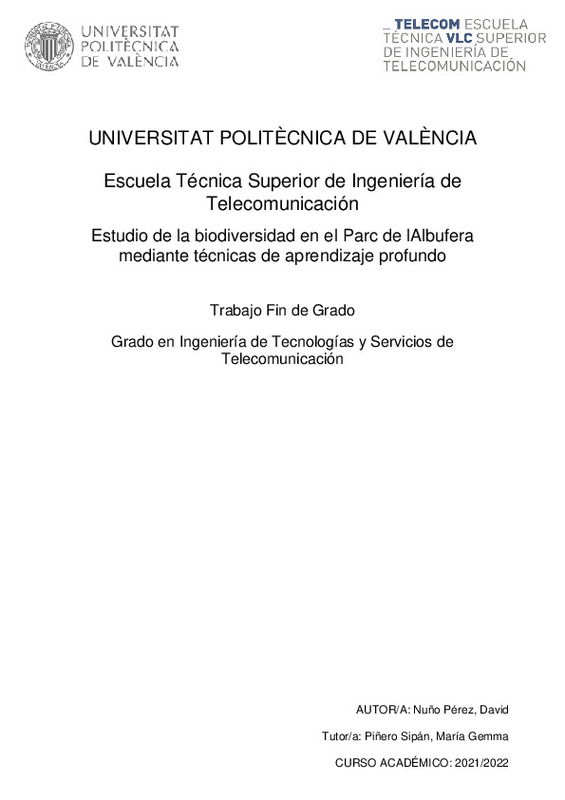JavaScript is disabled for your browser. Some features of this site may not work without it.
Buscar en RiuNet
Listar
Mi cuenta
Estadísticas
Ayuda RiuNet
Admin. UPV
Estudio de la biodiversidad en el Parc de l Albufera mediante técnicas de aprendizaje profundo
Mostrar el registro sencillo del ítem
Ficheros en el ítem
| dc.contributor.advisor | Piñero Sipán, María Gemma
|
es_ES |
| dc.contributor.author | Nuño Pérez, David
|
es_ES |
| dc.date.accessioned | 2022-10-15T06:57:31Z | |
| dc.date.available | 2022-10-15T06:57:31Z | |
| dc.date.created | 2022-07-19 | es_ES |
| dc.date.issued | 2022-10-15 | es_ES |
| dc.identifier.uri | http://hdl.handle.net/10251/187894 | |
| dc.description.abstract | [ES] La monitorización medioambiental para el análisis de hábitats de especies ha requerido tradicionalmente de un alto grado de participación humana tanto en la adquisición de información como en la supervisión del procedimiento. Las nuevas técnicas de adquisición de audio e imágenes, así como su posterior procesado permiten plantear su uso en la monitorización medioambiental con dos propósitos fundamentales: por un lado, la automatización del proceso (reduciendo el número de horas dedicadas a esta tarea por los investigadores) y, por otro, la extracción de información útil en el ámbito de la biología gracias a los modelos de aprendizaje máquina (machine learning) y especialmente a las novedosas técnicas de aprendizaje profundo (deep learning, DL). Uno de los objetivos de la monitorización medioambiental es determinar el grado de biodiversidad del entorno. Se entiende por biodiversidad la cantidad, variedad y variabilidad de los organismos vivos en una determinada zona. Su estudio es muy importante para el área de la biología, sobretodo para el estudio de fenómenos como el cambio climático o la interacción del hombre con el entorno. Los siguientes objetivos particulares pueden contemplarse a raíz de la estimación de la biodiversidad: - Presencia/ausencia de especies. - Estimación de la densidad/abundancia de especies. - Distribución espacial y temporal de especies. - Tendencias de abundancia de especies. Este TFG pretende estudiar la biodiversidad de especies de pájaros en el Parc de l¿Albufera de Valencia mediante el uso de técnicas de aprendizaje profundo (DL). En particular, este TFG se engloba en el proyecto de investigación DAPHNE - Deep-learning Analysis and cyber-PHysical systems applied to biodiversity in urban and Natural Environments de la Universidad de Sevilla en colaboración con la UPV y cuyas actuaciones se desarrollan en el Parque Nacional de Doñana y en el Parc de l¿Albufera. | es_ES |
| dc.description.abstract | [EN] Environmental monitoring for the analysis of habitats has traditionally required a high degree of human participation both in the acquisition of information and in the supervision of the procedure. New audio and image acquisition techniques, as well as their subsequent processing, allow their use in environmental monitoring with two fundamental purposes: on the one hand, the automation of the process (reducing the number of hours dedicated to this task by researchers) and, on the other hand, the extraction of useful information in the field of biology thanks to machine learning models and especially to the novel deep learning (DL) techniques. One of the objectives of environmental monitoring is to determine the degree of biodiversity of the environment. Biodiversity is understood as the quantity, variety, and variability of living organisms in a given area. Its study is very important for biologists, especially for the study of phenomena such as climate change or human interaction with the environment. The following objectives can be stated as a result of the estimation of biodiversity: - Species presence/absence. - Estimation of species density/abundance. - Spatial and temporal distribution of species. - Trends of abundance of species. This TFG aims to study the biodiversity of bird species in the Albufera Park of Valencia by using deep learning (DL) techniques. This TFG is included in the research project ¿Deep-learning Analysis and cyber-PHysical systems applied to biodiversity in urban and Natural Environments¿ (DAPHNE) of the University of Sevilla in collaboration with the UPV and whose actions are developed in the Doñana National Park and the Albufera Park. | en_EN |
| dc.format.extent | 45 | es_ES |
| dc.language | Español | es_ES |
| dc.publisher | Universitat Politècnica de València | es_ES |
| dc.rights | Reserva de todos los derechos | es_ES |
| dc.subject | Biodiversidad | es_ES |
| dc.subject | Parc de l'Albufera | es_ES |
| dc.subject | Clasificación de especies | es_ES |
| dc.subject | Aprendizaje profundo | es_ES |
| dc.subject | Biodiversity | en_EN |
| dc.subject | Albufera Park | en_EN |
| dc.subject | Species classification | en_EN |
| dc.subject | Deep learning | en_EN |
| dc.subject.classification | TEORIA DE LA SEÑAL Y COMUNICACIONES | es_ES |
| dc.subject.other | Grado en Ingeniería de Tecnologías y Servicios de Telecomunicación-Grau en Enginyeria de Tecnologies i Serveis de Telecomunicació | es_ES |
| dc.title | Estudio de la biodiversidad en el Parc de l Albufera mediante técnicas de aprendizaje profundo | es_ES |
| dc.title.alternative | Study of the biodiversity in the Albufera Park through deep learning techniques | es_ES |
| dc.title.alternative | Estudi de la biodiversitat al Parc de l'Albufera mitjançant tècniques d'aprenentatge profund | es_ES |
| dc.type | Proyecto/Trabajo fin de carrera/grado | es_ES |
| dc.rights.accessRights | Abierto | es_ES |
| dc.contributor.affiliation | Universitat Politècnica de València. Departamento de Comunicaciones - Departament de Comunicacions | es_ES |
| dc.contributor.affiliation | Universitat Politècnica de València. Escuela Técnica Superior de Ingenieros de Telecomunicación - Escola Tècnica Superior d'Enginyers de Telecomunicació | es_ES |
| dc.description.bibliographicCitation | Nuño Pérez, D. (2022). Estudio de la biodiversidad en el Parc de l Albufera mediante técnicas de aprendizaje profundo. Universitat Politècnica de València. http://hdl.handle.net/10251/187894 | es_ES |
| dc.description.accrualMethod | TFGM | es_ES |
| dc.relation.pasarela | TFGM\151196 | es_ES |
Este ítem aparece en la(s) siguiente(s) colección(ones)
-
ETSIT - Trabajos académicos [2408]
Escuela Técnica Superior de Ingenieros de Telecomunicación






